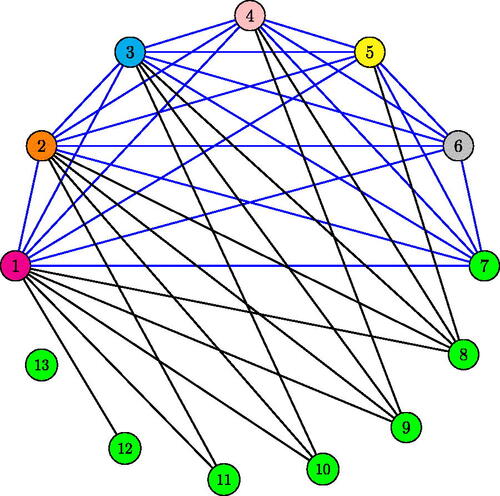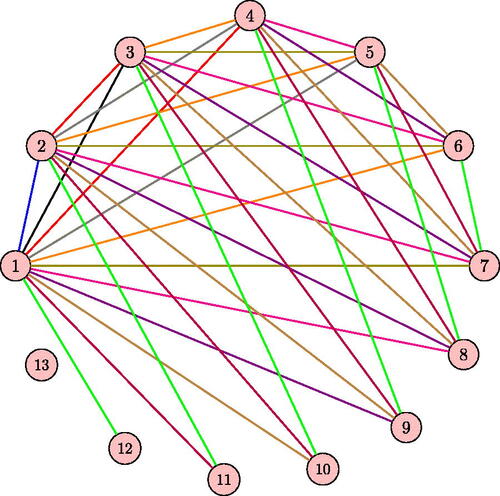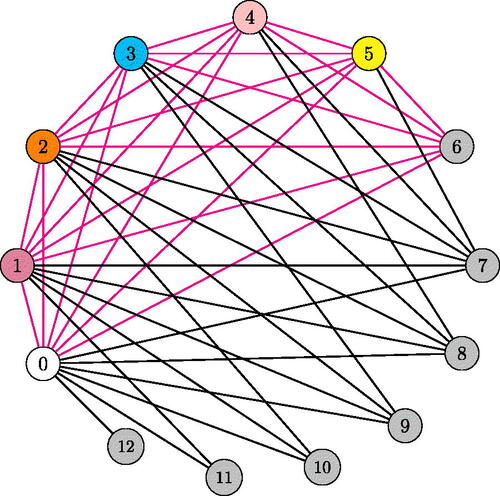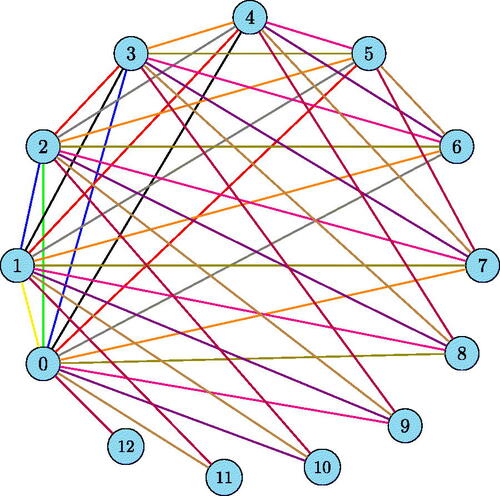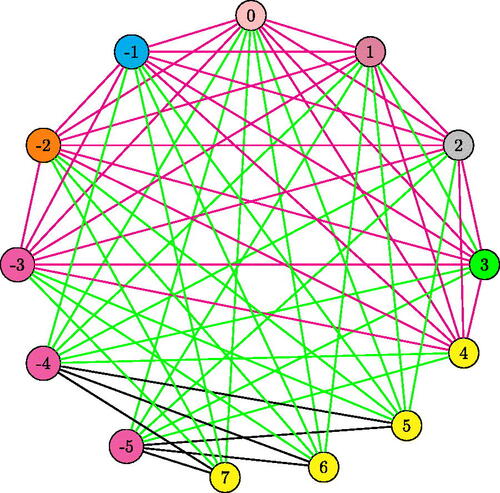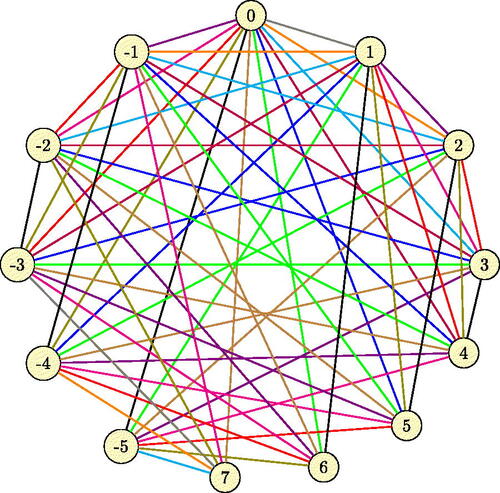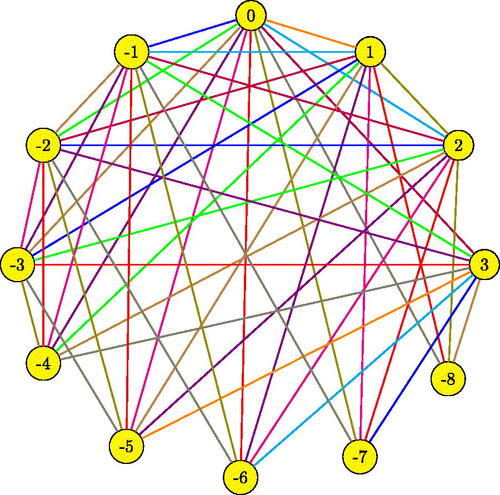 ?Mathematical formulae have been encoded as MathML and are displayed in this HTML version using MathJax in order to improve their display. Uncheck the box to turn MathJax off. This feature requires Javascript. Click on a formula to zoom.
?Mathematical formulae have been encoded as MathML and are displayed in this HTML version using MathJax in order to improve their display. Uncheck the box to turn MathJax off. This feature requires Javascript. Click on a formula to zoom.Abstract
A graph G is an integral sum graph (sum graph) if its vertices can be labeled with distinct integers (positive integers) so that e = uv is an edge of G if and only if the sum of the labels on vertices u and v is also a label in G. A graph G is perfect if the chromatic number of each of its induced subgraphs is equal to the clique number of the same. A simple graph G is of class 1 if its edge chromatic number and maximum degree are same. In this paper, we prove that integral sum graphs Gn, and
over the label sets
and
, respectively, are perfect graphs as well as of class 1 for
. We also obtain a few structural properties of these graphs.
1 Introduction
Harary [Citation6, Citation7] introduced the concepts of sum graphs and integral sum graphs. A graph G is called as an integral sum graph (sum graph) if the vertices of G can be labeled with distinct integers (positive integers) so that e = uv is an edge of G if and only if the sum of the labels on vertices u and v is also a label of a vertex in G. An anti-sum graph is defined [Citation11] as a graph G in which there exist a labeling such that two vertices are adjacent in G if and only if the sum of their labels is not a label of any vertex in G.
Different notations are used for integral sum graphs by different authors. For any non-empty set S of integers, let denote the integral sum graph on the vertex label set S, Gn denote the sum graph for
=
denote the integral sum graph for S =
, the integral sum graph with respect to
is denoted by
[Citation6, Citation7] which is generalized to
and
denote the integral sum graph for S =
[Citation12]. Throughout this paper, for integral sum graph
, we consider vi as the vertex with integral sum labeling i,
.
The order of a graph G is , the number of vertices in G. The join of two graphs A and B denoted by A + B is the graph
together with edges joining each vertex of A with all the vertices of B [Citation14].
Theorem 1.1.
[Citation12] For positive integers r and n, .
An assignment of colors to the vertices of a graph so that adjacent vertices have the distinct colors is called a proper coloring of the graph. A color class is the set of all vertices with any one color and that is an independent set. The chromatic number of a graph G is the minimum number of colors required to color the vertices of G for which G has a proper coloring [Citation5]. Similarly, an assignment of colors to the edges of a graph G in such a way that adjacent edges have distinct colors is termed as proper edge coloring. An edge color class is the set of all edges of G with any single color and it is an independent set of edges. The edge chromatic number
is defined as the minimum number of colors required to color the edges of G for which G has a proper edge coloring [Citation5]. A simple graph G is class 1 if
=
. It is class 2 if
=
.
The clique of a graph G is the maximal complete subgraph in G and its order is the clique number of G, denoted by [Citation5]. Clearly
= n. Here we denote the clique of the graph G by CG.
A graph G is perfect if for every induced subgraph of G, the clique number and the chromatic number have the same value. Equivalently, for every =
[Citation14]. A graph G is 1-perfect if
=
[Citation14]. It is also proved that graph G is perfect if and only if every induced subgraph of G is 1-perfect [Citation3].
Theorem 1.2.
[Citation8] The complement of a perfect graph is perfect as well.
Several graphs are proved as perfect [Citation1, Citation4, Citation14]. They include bipartite graphs and their line graphs, chordal graphs, comparability graphs, triangulated graphs, etc. Perfect graphs arise in the statistical competition of block designs and in graph coloring problems. Another application of perfect graphs is the optimal routing of garbage trucks related to urban science problems. The perfect graph is also closely related to perfect channels in communication theory [Citation9].
This paper contains 4 sections. Section 1 contains an introduction and some basic definitions and Section 2 presents a few structural properties which are required to prove results on integral sum graphs Gn, and
in the subsequent sections,
. In Section 3, we prove that sum graphs Gn and integral sum graphs
are perfect and in Section 4, we show that integral sum graphs
are perfect and graphs Gn,
and
are of class 1 for
.
While studying proper edge coloring of integral sum graphs, we felt that graphs Gn, and
must be perfect graphs and that is the motivation for this study.
All graphs we consider in this paper are simple and finite, and we follow Harary [Citation5] for all graph-theoretic notions which are not mentioned here.
2 Preliminaries
In this section, we present a few structural properties of integral sum graphs Gn, and
that are required to prove results in the subsequent sections,
.
Theorem 2.1.
[Citation5] (Vizing’s Theorem) For any graph G, the edge chromatic number satisfies the inequalities, .
A vertex and an edge of a graph are said to cover each other if they are incident [Citation5].
A set of vertices (edges) which covers all the edges (vertices) of a graph G is called a vertex cover (edge cover) for G. Vertex covering number (edge covering number) is the minimum cardinality among all the vertex covers (edge covers) for G and is denoted by or α0 (
or α1) [Citation5].
A set of vertices (edges) in G is independent if none of them are adjacent. The maximum cardinality among all the vertex (edge) independent set is called its vertex independence number (edge independence number) and is denoted by or β0 (
or β1) [Citation5]. We denote the independent set of the graph G by IG.
Theorem 2.2.
[Citation5] For any connected nontrivial graph G of order n, = n =
.
Lemmas 2.3
and 2.4 are related to clique, minimum vertex cover, minimum edge cover, maximum independent set and maximum matching and are given without proof since the proofs are obvious.
Lemma 2.3.
For every , the integral sum graph Gn has
Clique of Gn,
=
Minimum vertex cover of Gn
and =
.
Maximum independent set of Gn,
=
and =
Maximum matching of Gn
and =
.
Any sum graph
has no edge cover since the vertex corresponding to the biggest label which is a natural number is an isolated vertex in
. In particular, Gn has no edge cover,
.
Lemma 2.4.
For every integral sum graph , we have
Clique of
,
and
.
Minimum vertex cover of
Maximum independent set of
and =
.
Minimum edge cover of
and =
where k =
.
Maximum matching of
and =
.
Note 2.5. By putting r = 0 in Lemma 2.4, we obtain the corresponding properties of .
Note 2.6. In the integral sum graph of even order, every maximum matching is a perfect matching for
.
For any integral sum graph Gn, or
, maximum independent set, minimum vertex cover, minimum edge cover, and maximum matching need not be unique but clique is unique,
.
3 Sum graphs Gn and Integral sum graphs 
 are perfect
are perfect
In this section, we prove that for , sum graphs Gn and integral sum graphs
are perfect.
Theorem 3.1.
For a positive integer n, the sum graph Gn is perfect.
Proof.
Let Gn be the sum graph of order n obtained by the labeling defined by
. Let H be any induced subgraph of Gn. Our aim is to prove that
=
for all subgraphs H of Gn where
is the chromatic number of H and
is its clique number.
Gn is a split graph with clique =
and the independent set
. To prove the theorem we consider the following three cases of H.
Case 1. .
Every induced subgraph of a clique is another clique of order fewer than or equal to the maximal clique. And thereby H itself a clique and =
.
Case 2. .
Induced subgraph of an independent set is also an independent set and the clique number of any induced subgraph of an independent set is 1. This implies, =
= 1 for every
.
Case 3. .
In this case, vertices of H belong to either or
. Let V(H) =
where
and
. Let
. This implies that
= k =
where CH is the clique in H. If H itself is a clique, then H = CH and thereby
=
= k. Hence the result is true in this case. If H is not a clique, let
= k. This implies,
=
= k.
For each vertex , there exists atleast one
such that
(since
) so that there will not be a clique of higher order than that of
and thus vi and vj can be assigned with the same color. That is, the colors used in
are enough for coloring
. This implies,
=
= k. Hence we get
= k =
.
Thus in all the three cases we obtain =
for every induced subgraph H of Gn and thereby graph Gn is perfect for
. □
Illustration 3.2. Consider the sum graph G13 as given in . Vertices v1,v2,v3,v4,v5,v6 and v7 (vertices joined by edges with blue color) form a clique in G13 and . These vertices are colored by the colors
. All the remaining vertices are nonadjacent to v7 and so, they can be colored by c7. Or, the vertices v8,v9,v10, v11,v12 and v13 are nonadjacent to the vertices v6,v5,v4,v3,v2 and v1 respectively, and can be colored by the corresponding colors
. Therefore, the chromatic number of the sum graph G13 is 7. i.e.,
= 7 =
. Thus G13 is 1-perfect. Clearly every pair of nonadjacent vertices in G13 are also nonadjacent in any of its induced subgraphs. This shows that every induced subgraph of G13 is 1-perfect. This implies, graph G13 is 1-perfect and thereby G13 is perfect.
Corollary 3.3.
For every positive integer n, graph is perfect.
Proof.
The proof follows from Theorems 3.1 and 1.2. □
Theorem 3.4.
For every ,
the chromatic number of Gn is
;
the edge chromatic number of G1 is 0 and for
, the edge chromatic number of Gn is n – 2.
Proof.
The sum graph Gn is obtained by the labeling defined by
, i = 1 to n.
From Theorem 3.1, Gn is perfect and thereby the chromatic number of Gn is equal to its clique number. This implies,
=
=
. Hence we get the result (i). Vertex coloring and clique of G13 are shown in .
For n = 1, Gn is an empty graph and thus the edge chromatic number
= 0.
For , the maximum degree of sum graph Gn is
= n – 2. Using Theorem 2.1, we have,
. Here, we present the edge coloring of the sum graph Gn with exactly n – 2 colors so that
.
Let ck denote kth color assigned to an edge and Ck denote the color class of edges each with color ck in Gn, . Color the set of edges
of Gn with the color ck.
It is clear from the above edge coloring that colors c1 to are assigned to the edges of Gn and no more edge colors are required. And all the colors of edges incident at each vertex vi of sum graph Gn are all distinct since there are exactly n – 2 possibilities of j,
for which
in Gn,
. This implies,
= n – 2 for
. Hence we get the result (ii). □
Illustration 3.5. Consider the sum graph G13. The vertices v1,v2,v3,v4,v5,v6 and v7 in G13 (vertices joined by edges with blue color) form a clique, = 7 and
= 11. Since G13 is perfect,
=
which implies,
= 7 =
. As in the proof, color the set of edges
of Gn with the color ck. The colors of each edge of G13 is given as follows.
See with the edge coloring of G13 with 11 colors using the method given in the proof of Theorem 3.4. Here, .
Results are available for the composition of perfect graphs which allows different types of graph operations [Citation2]. But the graph operation join is not available yet. Following is the result corresponding to join of two perfect graphs.
Theorem 3.6.
Join of two perfect graphs is also perfect.
Proof.
Let G and F be two perfect graphs with =
= p and
=
= q. Also let J = G + F, the join of the graphs G and F. When we take the join of two graphs G and F, the clique in G together with clique in F form a higher clique of order p + q. i.e.,
= p + q. Let H be any induced subgraph of J. We have to prove that
=
.
Let = k and let CH be the clique in H of order k. Then
= |CH| = k =
. That is CH can be colored using k colors.
Let . For each vj
and vy
, there exist vi
and vx
such that
so that there does not exist a clique of higher order than that of
. Hence, the colors of vi and vx can be assigned to vj and vy, respectively. And thereby the vertices of D can be colored using the colors of vertices of CH. This implies,
=
=
. Thus, for every induced subgraph H of J,
=
. Thus the graph J is perfect. □
Theorem 3.7.
For every , the integral sum graph
is perfect.
Proof.
The integral sum graph = K1 + Gn where K1 = G1 is labeled with 0. Then using Theorems 3.1 and 3.6, the graph
is perfect,
. □
shows the clique in and its vertex coloring.
Theorem 3.8.
For every , the integral sum graph
has
the chromatic number
=
;
the edge chromatic number
= n.
Proof.
The integral sum graph is obtained by the labeling
defined by
, i = 0 to n.
Using Theorem 1.1,
which implies,
=
+
= 1+
using Theorem 3.4
For
, the maximum degree of integral sum graph
is
= n. Using Theorem 2.1, we get,
. Now, we present a proper edge coloring of
with n colors so that
= n.
Let ck denote kth color assigned to an edge and Ck denote the color class of edges, each with color ck in . Color all the edges in the set
with the same color ck. Clearly, the edges of
take at the most n colors since
. Also, there are n edges incident at the vertex v0, and all these n edges take n distinct colors. That is,
= n,
. See for the edge coloring of
and it can be done as the illustration 3.5 for G13. □
4 Integral sum graphs 
 are perfect
are perfect
In this section, we prove that for , (i) integral sum graphs
are perfect; (ii) the chromatic number of
=
and (iii) the edge chromatic number of
= r + n. These results are illustrated by examples.
Theorem 4.1.
For , the integral sum graph
is perfect.
Proof.
Using Theorem 1.1, since join operation is associative as well as commutative among undirected graphs. Graphs Gr and
are isomorphic without vertex labeling and so both are perfect by Theorems 3.1 whereas
is perfect by Theorem 3.7 for
. Therefore using Theorem 3.6, graph
is perfect for
. This implies, graph
is perfect for
. □
Illustration 4.2. Consider the integral sum graph given in . Vertices
(Vertices joined by the edges with magenta color) in
form a clique. Thus,
= 8. These vertices can be colored by 8 distinct colors, say
, respectively. Vertices
and
are nonadjacent to
and can be colored by c8, the color of
. Vertices v7, v6 and v5 are nonadjacent to v4 and can be colored by c4. Therefore,
= 8. This implies,
is 1-perfect. Likewise we can show that every induced subgraph of
is 1-perfect. This implies, graph
is perfect.
Theorem 4.3.
[Citation13] For ,
= 3.
= n + 1 for
.
= 2n for
.
In [Citation13] (also see [Citation10]), Vilfred proposed Theorem 4.4 (ii) as a conjecture and here we provide a proof.
Theorem 4.4.
For ,
the chromatic number of
is
=
;
the edge chromatic number of
is
= r + n.
Proof.
For and
, let
defined by
be the integral sum labeling of the graph
.
For
, integral sum graph
is perfect by Theorem 4.1. Therefore
=
=
follows from Lemma 2.4. Hence the result is true in this case. shows the vertex coloring and clique in
.
For
, the maximum degree of integral sum graph
is
= r + n. And using Theorem 2.1, we get,
. Here we present a proper edge coloring of the integral sum graph
with r + n colors so
for
.
Let ck denote kth color assigned to an edge and Ck denote the color class of edges, each with color ck in . For
, color the edges of
as follows.
cj,
; i.e., edge
is taking color cj,
;
,
and
;
,
;
,
;
,
;
,
;
,
and i < j and
,
and i < j.
It is clear from the above edge coloring that colors c1 to are assigned to the edges of
and no more edge colors are required. And also colors of edges at each vertex of
are all distinct by the following. By Theorem 1.1, we have
. Also,
.
In , colors c1, c2, …,
are assigned to the n + r edges incident at the vertex v0.
In , we get the following possible colors taken by its edges incident at each of its vertices under the coloring already assigned to the edges of
.
For
, distinct colors
, …,
are assigned to the r edges incident at vj. And these colors are also different from color cj of the edge
at v0.
For
, distinct colors
, …,
are assigned to the r edges incident at vn and these colors are different from color cn of the edge
at vn. Clearly,
r + n and thus the colors assigned are from the r + n colors only.
For
, distinct colors
, …,
are assigned to the r edges incident at vn and these colors are different from color cn of the edge
at vn. Clearly,
r + n and atmost r + n colors are assigned.
For
, distinct colors
, …,
are assigned to the n edges incident at
. And all these colors are different from color
of the edge
at
.
For
and
, distinct colors
, …,
are assigned to the n edges incident at
and all these colors are different from color
of the edge
at
.
For
and
, distinct colors
, …,
are assigned to the n edges incident at
and all these colors are different from color
of the edge
at
.
For
and
, distinct colors
, …,
are assigned to the n edges incident at
and all these colors are different from color
of the edge
at
.
Thus, in the above edge coloring of , edges of
take colors from the r + n colors and colors of edges incident at each vertex of
are all distinct.
In Gn, for and
, color of edge
is
and thereby edges of Gn are taking colors only from the colors
, …,
; edge colors
at vi are all distinct and also different from ci of the edge
at vi as well as that of other possible colors of edges which incident at vi in
where
and
. The same arguments also hold when i and j are interchanged.
In , for
and
, color of edge
is
and thereby edges of
are taking colors only from the colors
, …,
; edge colors
at
are all distinct and also different from
of the edge
at
as well as that of other possible colors of edges which incident at
in
where
and
. The same arguments also hold when i and j are interchanged in this case.
Thus, in the above edge coloring, edges of takes only r + n number of colors and colors of edges incident at each vertex of
are all distinct and thereby
=
since
by Theorem 2.1. □
Illustration 4.5. Consider the integral sum graph , the case where
. We know
= 11. Using the algorithm given in the above proof, we can color the edges of
as follows.
See for the edge coloring of . Here we colored the integral sum graph
using 11 colors. That is,
= 11 = 8 + 3. Similarly the integral sum graph
, the case where
, can be colored using 12 colors by the algorithm given in the above proof. That is
= 12 = 5 + 7. See for the edge coloring of
.
Theorem 4.6.
For positive integers r and n, integral sum graphs Gn, and
are of class 1.
Proof.
Using Theorems 3.4, 3.8 and 4.4, we get = n – 2 =
= degree of the vertex with label 1,
= n =
= degree of the vertex with label 0 and
= r + n =
= degree of the vertex with label 0. □
Acknowledgments
The first, second and fourth authors express their sincere gratitude to the Central University of Kerala, Periye, Kasaragod - 671316, Kerala, India for providing facilities to carry out this research work. Also, the authors are thankul to the anonymous reviewers for their valuable comments and suggestions to improve the presentation of the paper.
Disclosure statement
The authors declare that there is no conflict of interests regarding the publication of this paper.
Additional information
Funding
References
- Berge, C. (1960). Les problmes de coloration en thorie des graphes. Publ. Inst. Statist Univ. Paris. 9: 123–160.
- Cornuejols, G., Cunningham, W. H. (1985). Compositions for perfect graphs. Discrete Math. 55: 245–254.
- Coudert, O. (1997). Exact Coloring of Real-Life Graphs is Easy. DAC ’97. In: Proceedings of the 34th annual Design Automation Conference, pp. 121–127.
- Hajnal, A., Surnyi, J. (1958). ber die auflosung von graphen in vollstandige teilgraphen. Ann. Univ. Sci. Budapest Eotvos, Sect. Math. 1: 113–121.
- Harary, F. (1969). Graph Theory. Reading, MA: Addison-Wesley.
- Harary, F. (1990). Sum graphs and difference graphs. Congr. Numer. 72: 101–108.
- Harary, F. (1994). Sum graphs over all integers. Discrete Math. (124): 99–105.
- Lovász, L. (2006). Normal hypergraphs and the perfect graph conjecture. Discrete Math. 306: 867–875.
- Tucker, A. (1973). Perfect graphs and an application to optimizing municipal services. Siam Review 15(3): 585–590.
- Vilfred, V., Beineke, L. W., Florida, L. M., Abraham, J. K. (2022). A study on edge coloring and edge sum coloring of integral sum graphs. arXiv:2203.00409.
- Vilfred, V., Florida, L. M. (2013). Anti-integral sum graphs and decomposition of Gn, Gnc and Kn. In: Proc. Int. Conf. on App. Math. and Theoretical Comp. Sci., St. Xaviers College of Engg., Nagercoil, TN, India, pp. 129–133.
- Vilfred, V., Florida, L. M. (2012). Integral sum graphs and maximal integral sum graphs. Graph Theory Notes of New York, MAA. 63: 28–36.
- Vilfred, V., Florida, L. M. (2013). New families of integral sum graphs - edge sum class and chromatic integral sum number. In: Proc. Int. Conf. on App. Math. and Theoretical Comp. Sci., St. Xaviers Catholic College of Engg., Nagercoil, TN, India, pp. 177–182.
- West, D.B. (2005). Introduction to Graph Theory. Harlow: Pearson Education.

